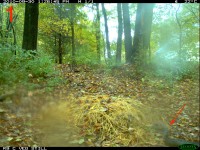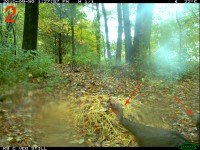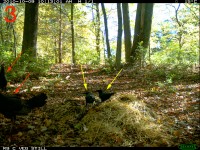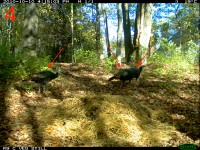Plain text indicates the location (see corresponding red arrow) of the animal(s) in image; bold text indicates the basis of the identification of the animal(s).
1 – In lower right margin of image, facing left. [Single wild turkey: this lateral view (partial) of the upper body shows the bare (featherless) head, the large size, and dark brown plumage that are typical of the wild turkey.]
2 – In lower right margin of image (two). [Two wild turkeys: this lateral view (partial) of the upper body shows the bare (featherless) head, the large size, and dark brown plumage that are typical of the wild turkey.]
3 – Along left margin of image (two); plus crows (yellow arrows). [Two wild turkeys: view shows the large size, dark brown plumage (note tail fanning by bird closest to pile), long legs, and bare head that are characteristic of the species.]
4 – In background behind pile (three), facing right. [Three wild turkeys: view shows the large size, dark brown plumage, long legs, and bare head that are characteristic of the species. Note that the furthest individual is somewhat obscured by the middle bird.]
5 – On left margin of image, facing right. [Single wild turkey: this lateral view of primarily the upper body shows the bare (featherless) head, the large size, and dark brown plumage that are typical of the wild turkey.]
6 – On right margin of image, facing left. [Single wild turkey: this lateral view of the head alone shows its bare (featherless) condition. Note that its beak is not as sharply curved and head not as pink as that of the turkey vulture, a species that also has a featherless head.]






